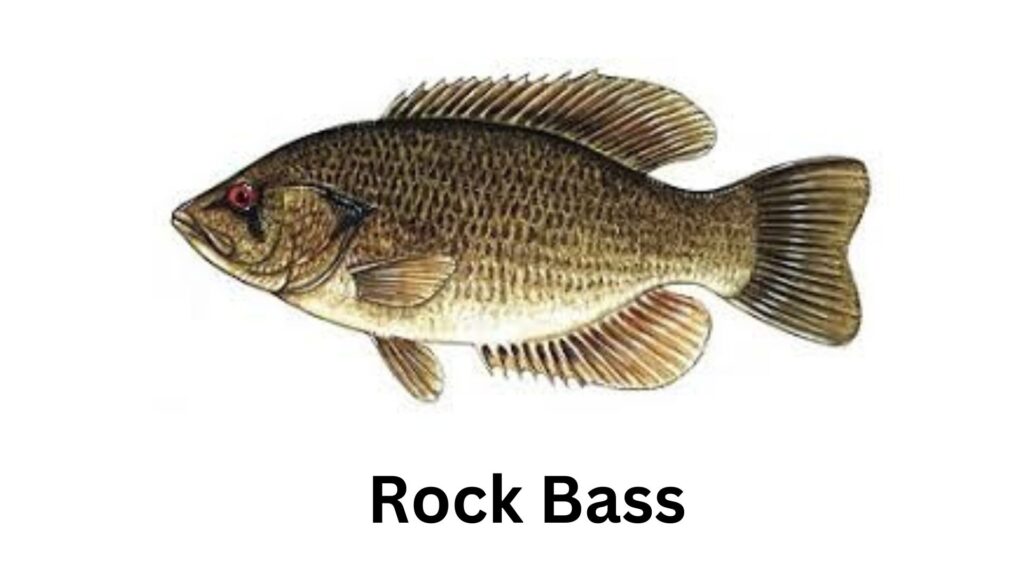
Rock Bass
Rock bass, a fascinating species in freshwater ecosystems, is beloved by anglers for its unique characteristics and ease of catch. These small but aggressive fish are found primarily in North America and offer a thrilling fishing experience of ecological importance. This guide deepens into everything you need about rockbass, from their habitat to fishing techniques.
What Is Rock Bass’s?
Rock bass, scientifically known as Ambloplites rupestris, is a freshwater fish from the sunfish family. Known for their robust body and distinctive red eyes, these fish thrive in lakes, rivers, and streams with rocky or weedy areas.
Key Features of Rock Bass
- Appearance: Rock bass have a stocky body with a dark green or brown coloration and a mottled pattern of spots.
- Size: They typically grow 6–10 inches long, though some may reach 12 inches.
- Behavior: Rockbass are opportunistic feeders known for their aggressive strikes.
Where Can You Find Rock Basses?
Rock basses are widely distributed across North America, thriving in freshwater habitats. They prefer areas with rocky bottoms, submerged structures, and slow-moving waters.
The Ideal Habitat for Rock Bass‘s
- Lakes and Rivers: Look for rock basses in clear, shallow waters with plenty of cover, such as fallen logs or boulders.
- Preferred Conditions: They thrive in moderate temperatures and clean water.
- Geographic Range: Common in the Midwest, Great Lakes region, and parts of Canada.
Techniques for Catching RockBass
Fishing for rockbass is enjoyable and rewarding, as they readily bite on various baits and lures. Their aggressive nature makes them a great choice for beginners and experienced anglers alike.
Best Baits and Lures for Rock Bass‘s
- Live Baits: Worms, minnows, and crayfish are highly effective.
- Artificial Lures: Small jigs, crankbaits, and spinnerbaits work well, especially in rocky areas.
Seasonal Tips for Success
- Spring: Focus on shallow waters during the spawning season.
- Summer: Target shaded areas or deeper waters during hot weather.
- Fall: Rock bass’s become more active, feeding aggressively before winter.
RockBass vs. Other Bass Species
While rock bass share similarities with other bass species, they have distinct traits that set them apart. Understanding these differences helps anglers identify and target them more effectively.
Key Differences Between RockBass and Smallmouth Bass
- Appearance: Smallmouth bass have a more elongated body than the stockier rockbass.
- Habitat: Rock basses prefer slower-moving waters, while smallmouth basses are often found in faster currents.
- Behavior: Rockbass are less elusive and easier to catch.
The Role of Rock Bass in Ecosystems
Rock bass plays a crucial role in freshwater ecosystems by controlling prey populations and contributing to the biodiversity of their habitat. Their presence helps maintain the ecological balance of aquatic environments.
Conservation and Sustainable Fishing Practices
Ensuring the sustainability of rock basses populations is vital for preserving their ecological and recreational value. Anglers can contribute by adopting ethical practices.
Catch-and-Release Guidelines
- Use barbless hooks to minimize injury.
- Handle fish with wet hands to protect their scales and slime layer.
- Release fish back into their habitat promptly.
Importance of Local Regulations
Adhere to fishing limits and size restrictions set by local authorities to prevent overfishing.
FAQs
- What are the best baits for catching rock bass?
Live baits like worms and minnows are ideal for rockbass. Artificial options such as small jigs and spinners work effectively in rocky areas. - Where can I fish for rock basses?
Rockbass are commonly found in lakes, rivers, and streams with clear water and rocky or weedy bottoms. Look for submerged structures or shaded spots. - How big can rockbass grow?
Rock bass grow between 6 and 10 inches on average, but some may reach up to 12 inches in optimal habitats. - What time of year is best for rock basses fishing?
Spring and summer are the best seasons, as rockbass are more active during these periods, especially during spawning. - Are rock bass edible?
Yes, rock bass are safe to eat and have a mild, flaky texture. They are popular for frying, baking, or grilling.
Read Also: Rock Bass





